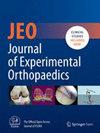The HKA axis varies significantly with knee motion: A robot-assisted intraoperative evaluation during total knee arthroplasty supports the use of dynamic, not static, alignment classifications
Abstract
Purpose
New alignment classifications based on phenotype reproduction have recently been introduced in total knee arthroplasty (TKA) as alternatives to traditional mechanical alignment. These classifications were designed according to the static hip–knee–ankle angle (sHKA) measurement from long leg radiographs (LLRs). This study aimed to understand whether and how the HKA varied throughout the knee's range of motion (ROM) during robot-assisted TKA.
Methods
This prospective, bi-centric cohort study involved 107 consecutive patients undergoing primary robot-assisted TKA. The surgical technique adhered to restricted kinematic alignment (HKA ± 3°) with asymmetric gap balancing principles. The HKA's dynamic variation (dHKA) was assessed intraoperatively at full extension, as well as at 30°, 45°, 60°, 90° and 120°, both before bone cuts and after the positioning of the trial components. The overall cohort was initially analyzed, followed by a subgroup analysis based on varus, neutral and valgus phenotypes. A descriptive analysis was conducted to evaluate dHKA trends. Collected data were then analyzed using one-way repeated measures analysis of variance with Bonferroni correction and Bland–Altman plots to assess significant variations in dHKA across the ROM during flexion and to quantify outliers from the established safe boundaries of ±3°.
Results
Out of 107 knees, the pre-cut dHKA demonstrated a biphasic trend, decreasing in varus until 60° and then transitioning toward valgus, with significant differences primarily noted at 90° and 120°. Post-cut, the dHKA exhibited an overall varus trend, increasing from full extension to 60° before experiencing a partial recovery. Significant differences were detected primarily at the initial flexion angles. Outlier rates increased with flexion: pre-cut from 6.5% to 43.0%, and post-cut from 1.9% to 30.8%, highlighting progressive inter-individual variability throughout. Although the analysis was stratified by knee phenotype, the post-cut dHKA trend did not differ among the various phenotypes or in comparison to the overall cohort trend.
Conclusions
The main finding of the current study was that intraoperative dHKA differs significantly from sHKA during robot-assisted TKA. Moreover, the sHKA was limited in predicting the actual kinematic HKA. Planning the final TKA alignment on static, standing LLRs may have limited value compared to intraoperative planning conducted with enabling technologies.
Level of Evidence
Level 3.


 求助内容:
求助内容: 应助结果提醒方式:
应助结果提醒方式:


